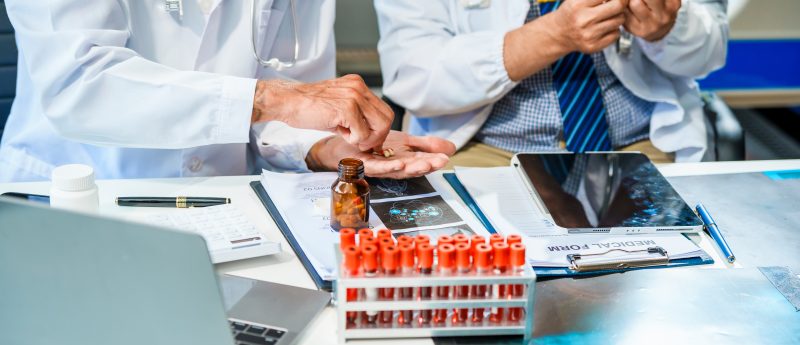Patient-centric sampling: an interview with the PCSIG founding members

Bioanalysis Zone interview with the Patient Centric Sampling Interest Group (PCSIG) founding members: Neil Spooner (Spooner Bioanalytical Solutions, Cambridge, UK) Florian Lapierre (Trajan Scientific and Medical, Fribourg, Switzerland), Jinming Xing (Novartis, MA, USA) and Tim Richards (SeventhSense Biosystems, MA, USA).
- What is patient-centric sampling?
For many years, professionally administered venipuncture has been a standard way for blood sample collection, where blood is drawn from a vein through the use of a needle. With the help of new, predominantly capillary blood collection technologies and devices, we now can make the process less invasive, more convenient and more patient-centric. With a patient-centric sampling approach, individuals may collect their blood samples remotely by themselves, or with the help of a caregiver. Where appropriate, these collections may take place in the patient’s own home.
- Why are you so passionate about patient-centric sampling?
Patient-centric sampling will revolutionize the way blood samples are taken, from the physician’s office to clinical trials, from consumer’s home to the Olympic stadium. Through its use, we are challenging the status quo to have more convenient and less invasive ways of getting samples, and ultimately provide better care and experience to our patients and consumers.
- You have just launched the PCSIG website – what was the inspiration behind starting the Patient Centric Sampling Interest Group (PCSIG) and creating the new online resource?
The PCSIG is a community of individuals and organizations that are interested in furthering the widespread understanding and routine implementation of novel technologies for the collection and analysis of high-quality blood samples to enable improved healthcare and wellbeing for the entire population. The group came together following the CPSA USA 2017 event in Langhorne, PA, USA. It was apparent from those attending (including representatives of technology innovators, pharmaceutical companies, central analytical laboratories, contract research organizations, etc.) that there was an appetite for change in the way that we collect and analyze blood samples and a realization that such a change would be far too great a feat for any individual, or organization to progress alone. Hence, it was agreed that working together on areas of non-competitive common interest would be the best way to proceed. Since then, it has been agreed amongst the members of the PCSIG that one of the best ways to spread the word about these technologies and workflows was to launch a website, which would be reflective of the aims of the community and act as a catalyst for change.
- To which population or industry is patient-centric sampling of greatest value?
In terms of population, patient-centric sampling can be applied for anyone, at anytime, anywhere. That means that no matter where the person lives, his or her health condition, there are solutions for collecting blood samples safely and efficiently while maintaining patient comfort and convenience. Patient-centric sampling tools ensure sample integrity throughout the sample journey from the patient to the laboratory where it will be analyzed; Those same laboratories where regular clinical samples are sent to, to ensure consistency of results for the patient and physician.
In terms of industry, patient-centric sampling has the greatest value where standard phlebotomy cannot serve or is impractical. For instance, for a physician performing longitudinal monitoring of a therapeutic drug on people with chronic disease(s), or for the pharmaceutical industry who want to perform novel clinical trials accessing a larger spectrum of population groups or geographical settings, or a governmental institution who wants to facilitate the establishment of a surveillance program with greater impact and participation rate, or simply for a person who just wants to monitor the status of their health using laboratory standards.
- Has the COVID-19 pandemic changed the adoption of patient-centric sampling technologies?
Yes, with the novel coronavirus SARS-CoV-2 and the COVID-19 pandemic outbreak, a new world of social distancing has been adopted where home-office and avoiding crowded areas are the new norm. This generated a significant impact on the health of people who are still relying on a traditional healthcare system. Physicians, pharma industries and regulators see the advantages of patient-centric sampling to facilitate the paradigm shift toward new healthcare solutions. Patient-centric sampling tools have the potential to better serve populations and health systems whilst minimizing their exposure. They enable providers to progress on patient care while being physically distant but remain connected.
- What is the purpose of PCSIG and how can others get involved?
The purpose of the PCSIG is to build a coalition of individuals who share a common interest to serve patients; by improving access and quality of healthcare and by putting their needs at the center of our efforts. The group is open and invites all those interested in facilitating awareness, development and implementation of novel sample collection technologies and practices so that patients can easily access the healthcare system, regardless of location or conditions. The group relies on a high degree of collaboration and engagement across all members and stakeholders, including healthcare providers, consumers, patients, regulators, fellow scientists and the media to understand and address their concerns surrounding patient-centric blood sampling and analysis.
If this idea is attractive and you’re interested in helping to improve the delivery of healthcare, please contact us at [email protected] to discuss how you can participate.
- Looking ahead, what goals would you like to achieve now that the PCSIG has been set up?
The community will continue to listen to its members with regards to areas where we can work on together to make an impact and further the widespread implementation of these technologies for the benefit of human wellbeing. Current examples of this include obtaining feedback from healthcare practitioners and patients on their considerations for current and future approaches to blood sampling and analysis. Members are also running a clinical trial to gather data on the impact these technologies have upon the recruitment and retention of subjects into clinical trials. Other endeavors include looking at how we standardize information associated with the technology, such as expiry dates, sample collection details, patient details, etc, so that manufacturers and users have a uniform way of working with these technologies, regardless of the provider and laboratory. Overall, we are looking to define who the key stakeholders are for current and future blood sampling and analysis approaches and then to understand and engage with them to facilitate the broad acceptance and adoption of these technologies for the benefit of all involved, from innovators, to laboratories, healthcare providers, consumers and most importantly, the patients.






